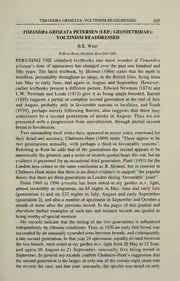
Timandra griseata Petersen (Lep.: Geometridae): voltinism readdressed PDF
Preview Timandra griseata Petersen (Lep.: Geometridae): voltinism readdressed
TIMANDRAGRISEATA: VOLTINISMREADDRESSED 105 TIMANDRA GRISEATA PETERSEN (LEP.: GEOMETRIDAE): VOLTINISM READDRESSED B.K. West 36BriarRoad,Dartford,KentDAS2HN. PERUSING THE standard textbooks one must wonder if Timandra griseata's time of appearance has changed over the past one hundred and fifty years. The latest textbook, by Skinner (1984) states that the moth is bivoltine, presumably throughout its range, in the British Isles, flying from late May to early June, and again in August and September. However, earlier textbooks present a different picture. Edward Newman (1874) and L.W. Newman and Leeds (1913) give it as being single-brooded. Barrett (1895) suggests a partial or complete second generation at the end of July and August, probably only in favourable seasons or localities, and South (1939), perhaps merely following Barrett, also suggests that there may sometimes be a second generation of moths in August. Thus we are presented with a progression from univoltinism, through partial second brood to bivoltinism. Two outstanding local works have appeared in recent years, renowned for their detail and accuracy. Chalmers-Hunt (1969) states "There appear to be two generations annually, with perhaps a third in favourable seasons". Referring to Kent he adds that of the generations the second appears to be numerically the greatest, and a series ofrecords quoted bears this out, but no evidence is presented for an occasional third generation. Plant (1993) for the London area comes to the same conclusion as B. Skinner, but in contrast to Chalmers-Hunt states that there is no direct evidence to support "the popular theory that there are three generations in London during 'favourable' years". From 1969 to 1996 griseata has been noted at my garden m.v. light, almost invariably as singletons, on 85 nights in May, June and early July (generation 1) and on 237 nights in July, August and early September (generation 2), and also a number of specimens in September and October a month or more after the previous record. In the pages of this journal and elsewhere further examples of such late and isolated records are quoted as being worthy ofspecial mention. My records indicate that the timing of the two generations is influenced independently by climatic conditions. Thus, in 1970 an early first brood was succeeded by an unusually extended time between broods, and consequently a late second generation. In that year 24 specimens, equally divided between the two broods, were noted at my garden m.v. light from 28 May to 12 June, and again 10 August to 21 September, unusually five being noted in September. In general my records confirm Chalmers-Hunt's suggestion that the second generation is the larger; in only one ofthe twenty-eight years was the reverse the case, and that year, unusually, the species was noted on only 106 ENTOMOLOGIST'S RECORD, VOL. 109 25.V.1997 one occasion. On the other hand no first generation specimens were recorded in six of the years. In eighteen of the years the normal sequence of second generation records ended in August, in 1982 as early as 9 August, but was followed by an isolated late specimen on 15 September, and in 1992 14 second brood specimens were noted between 7 July and 8 August, to be followed by two specimens on 15 and 21 September, 38 and 44 days respectively later. TIMANDRAGRISEATA: VOLTINISMREADDRESSED 07 1 The literature, especially this journal, contains several references to isolated, late sightings of T. griseata, and the following have come to my notice: Bradwell-on-Sea, Essex, 1 Novermber 1958 (Dewick, Ent. Rec. 71: 14); Stanford le Hope, Essex, 24 October 1968 (Tomlinson, Ent. Rec. 81: 234); Blandford, Dorset, 13 October 1960 (de Worms, Ent. Rec. 82: 60); Outwood, Surrey, 31 October 1970 (K.L. Evans, 1973, A Survey of the Macro-lepidoptera ofCroydon andNorth-eastSurrey)', Eastbourne, Sussex, 16 October 1976 (Parsons, Ent. Rec. 91: 149); Ninfield, Sussex,29 October 1978 (Parsons, Ent. Rec. 91: 149). Chalmers-Hunt {op. cit.) contains several October records listed as the final dates in sequences containing only the first and last dates, thus negating much oftheir significance. Contra-indicating an occasional partial third generation is the lack of evidence of second-brood larvae feeding up quickly to produce such imagines, indeed, Barrett {op. cit.) although stating that a second generation of moths may be produced in this way, adds that second-brood eggs laid in August took longer in hatching and the resultant larvae went into hibernation when half-grown in October. However, that is but one example. I suspect that rather more than ten late, isolated specimens would have been recorded at my garden m.v. light had I not been abroad for most of September on three occasions, and October for nine of the twenty-eight years. However the significance of such late sightings largely rests with the rearing in captivity, under as near natural conditions as possible, of third generations of moths; perhaps someone can already supply information regarding this? References Barrett, C, 1895.Moths oftheBritishIsles, Vol. VIII. Lovell, Reed & Co. Ltd., London. Chalmers-Hunt, CM., 1969. The Butterflies andMoths ofKent, in Entomologist's Rec. J. Var. 81. Newman, E., 1874. An illustratedNaturalHistory ofBritish Moths, Robert Hardwicke, London. Newman, L.W. & Leeds, H., 1913. Textbook ofBritish Butterflies andMoths. Gibbs & Bamford. Plant, C.W., 1993.LargerMoths oftheLondonArea. London Natural History Society. Skinner, B., 1984.Moths oftheBritishIsles. Viking. South, R., 1939. Moths oftheBritishIsles. Wame.
